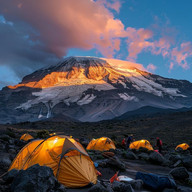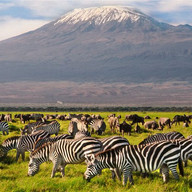Conquer Kilimanjaro: The Ultimate Guide to Trekking Africa's Highest Peak
- Sanaa Rajkumar
- Mar 10
- 4 min read
Updated: Mar 14
So, You Want to Climb Kilimanjaro? Let’s Talk.
Mount Kilimanjaro. Just saying the name stirs something inside adventurers. It’s Africa’s tallest mountain, standing at a staggering 5,895 meters (19,341 feet). Unlike technical peaks that require ropes and ice axes, Kilimanjaro is often referred to as a "walkable mountain". Sounds simple enough, right? Well, not so fast. While you don’t need mountaineering skills, altitude sickness, exhaustion, and unpredictable weather can turn this trek into one of the toughest challenges you’ll ever face. But don’t let that scare you—thousands of trekkers summit Kilimanjaro every year, and with the right preparation, so can you.
So, how do you go from daydreaming about standing on that summit to actually making it happen? Let’s break it down.
Which Route is Right for You?
One of the first decisions you’ll have to make is choosing the right route. Each has its own pros and cons, and picking the one that suits your fitness level, schedule, and acclimatization needs can be the difference between success and turning back halfway.
Marangu Route (5-6 days) – Known as the "Coca-Cola Route," this is the only trail with hut accommodations. It’s considered the easiest on paper, but because of its shorter duration, acclimatization can be a challenge. Less time to adjust = lower success rate.
Machame Route (6-7 days) – The "Whiskey Route" is more scenic, has better acclimatization, and is one of the most popular choices. It’s tougher than Marangu, but the extra challenge pays off with stunning landscapes and a higher summit success rate.
Lemosho Route (7-8 days) – This one’s for those who want the best possible experience. It’s long, but that means more time to acclimate. If you can spare the extra days, this is a top choice for increasing your chances of summiting.
Rongai Route (6-7 days) – Coming from the north, this route is drier, less crowded, and great for those trekking during the rainy season. However, it lacks some of the dramatic scenery that other routes offer.
Northern Circuit Route (8-9 days) – The longest, least crowded, and arguably the best in terms of acclimatization and views. If you have time, this is the ultimate way to do Kilimanjaro.
How to Train for Kilimanjaro (Because Yes, You Need to Train)
A common mistake people make is assuming that because there’s no technical climbing involved, they don’t need to train. That’s like signing up for a marathon without practicing. Here’s how to prepare:
Cardio, Cardio, Cardio – Your heart and lungs are about to be put to the test. Running, cycling, and swimming will improve endurance. But nothing beats actual hiking with a loaded backpack.
Strength Training – Those legs are going to be working overtime. Squats, lunges, and stair climbing will help with endurance and stability.
Hiking with a Pack – Strap on your daypack and hit the trails, preferably with some elevation gain. This will get your body used to carrying weight over long distances.
Practice at High Altitude (If Possible) – If you live near mountains, train at higher elevations to get used to lower oxygen levels. If not, don’t worry—just go slow on Kilimanjaro, and your body will adapt.
The Packing List: What You Absolutely Can’t Forget
Your gear can make or break your climb. Here’s what you need:
Clothing:
✔️ Base layers (moisture-wicking, NOT cotton)
✔️ Insulating layers (fleece or down jacket)
✔️ Waterproof jacket and pants
✔️ Warm gloves, hat, and balaclava
✔️ Trekking pants and shirts (quick-dry)
✔️ Gaiters (to keep rocks and mud out of your boots)
Footwear:
✔️ Sturdy, broken-in trekking boots (blisters will ruin your trip)
✔️ Warm, moisture-wicking socks
✔️ Camp shoes for the evenings
Gear:
✔️ A comfortable, well-fitting backpack
✔️ Trekking poles (your knees will thank you)
✔️ Headlamp with extra batteries
✔️ High-SPF sunscreen and lip balm (sunburn at altitude is brutal)
✔️ Hydration system (hydration bladder or multiple water bottles)
✔️ Sleeping bag rated for -10°C to -20°C
Health & First Aid:
✔️ Diamox (for altitude sickness, consult your doctor first)
✔️ Painkillers, band-aids, and blister treatments
✔️ Electrolyte tablets and high-energy snacks
✔️ Personal medications and hygiene essentials
Dealing with Altitude Sickness: The Unspoken Challenge
Altitude sickness is the great equalizer. It doesn’t matter if you’re a marathon runner or a couch potato—if your body doesn’t acclimate well, you’ll feel it. Symptoms include headaches, nausea, dizziness, and shortness of breath. So how do you combat it?
Pole, Pole (Slowly, Slowly) – This is the golden rule. The slower you go, the better your body adapts.
Stay Hydrated – Drink at least 3-4 liters of water a day.
Take Rest Days (if possible) – The longer the trek, the better your chances of summiting.
Listen to Your Guide – If they say you need to descend, don’t fight it. Altitude sickness isn’t something to mess around with.
Summit Night: The Final Push
This is what you’ve trained for. The toughest part of the climb starts around midnight, with temperatures dropping well below freezing. You’ll be exhausted, moving at a snail’s pace, and questioning your life choices—but keep going. The sun will rise, and when you finally reach Uhuru Peak, the view (and the overwhelming sense of accomplishment) will make every struggle worth it.
Final Tips for a Successful Kilimanjaro Trek
Book with a reputable trekking company – Safety first!
Eat, even when you don’t feel like it – You need energy to keep moving.
Bring something to entertain yourself – Cards, a book, or a journal. There’s a lot of downtime at camp.
Enjoy the journey – The summit is the goal, but the trek itself is an adventure of a lifetime.
Conclusion: Is Kilimanjaro Worth It?
Absolutely! It’s challenging, breathtakingly beautiful, and a true bucket-list adventure. It’s not just about reaching the top—it’s about pushing yourself, embracing the journey, and experiencing something truly unforgettable. So, are you ready to take on Africa’s tallest peak? The mountain is waiting.
Join Us for the Ultimate Kilimanjaro Experience!
If you’re ready to conquer Kilimanjaro and want expert guidance every step of the way, check out our Kilimanjaro trekking packages at Apex Summit Trails. Our experienced guides, carefully planned itineraries, and personalized support will give you the best chance of standing at the Roof of Africa. Let’s make this adventure happen!





















Комментарии